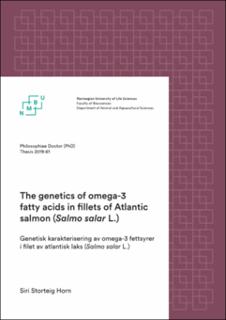| dc.contributor.advisor | Meuwissen, Theo | |
| dc.contributor.advisor | Sonesson, Anna K. | |
| dc.contributor.advisor | Ruyter, Bente | |
| dc.contributor.author | Horn, Siri Storteig | |
| dc.date.accessioned | 2022-12-19T09:22:58Z | |
| dc.date.available | 2022-12-19T09:22:58Z | |
| dc.date.issued | 2019 | |
| dc.identifier.uri | https://hdl.handle.net/11250/3038412 | |
| dc.description.abstract | Decreasing contents of the omega-3 fatty acids EPA and DHA in farmed Atlantic salmon reduces the nutritional value for consumers and influences physiological processes in the fish. Most studies of physiological omega-3 effects in Atlantic salmon have focused on responses to changed dietary levels. However, there are inherent differences in contents of EPA and DHA between Atlantic salmon fed the same diet. Revealing the metabolic differences between these individuals may contribute towards the goal of producing healthy fish of high nutritional value. Previous studies have showed the potential of selective breeding to increase the total n-3 LC-PUFA levels in salmon tissues, but knowledge on the genetic parameters for individual muscle fatty acids and their relationships with other traits were lacking.
The overall aim of this thesis was to identify the genetic basis and underlying biological mechanisms associated with omega-3 content in Atlantic salmon fillet. For this purpose, the Atlantic salmon from a SalmoBreed AS broodstock population studied were reared together under the same conditions and fed the same diet throughout their life, in order to reduce environmental factors to a minimum. | en_US |
| dc.description.abstract | Minkende innhold av omega-3-fettsyrene EPA og DHA i oppdrettslaks reduserer næringsverdien for forbrukerne og påvirker fysiologiske prosesser i fisken. De fleste studier av fysiologiske effekter av omega-3 i atlantisk laks har fokusert på respons på forskjellige nivåer av omega-3 i fôret. Det er imidlertid individuelle forskjeller i innholdet av EPA og DHA mellom atlantisk laks gitt samme fôr. Å avdekke de metabolske forskjellene mellom disse individene kan bidra til målet om å produsere sunn fisk med høy næringsverdi. Tidligere studier har vist et potensial for selektiv avl for økt totalnivå av omega-3 fettsyrer i laksevev, men kunnskap om de genetiske parameterne for individuelle fettsyrer og deres sammenheng med andre egenskaper manglet.
Det overordnede målet med denne avhandlingen var å identifisere det genetiske grunnlaget og underliggende biologiske mekanismer assosiert med omega-3 innhold i filet av atlantisk laks. Derfor studerte vi oppdrettslaks, fra en SalmoBreed avlspopulasjon, som levde under de samme forholdene og fôret med samme diett gjennom hele livet, slik at miljøfaktorer ble redusert til et minimum. | en_US |
| dc.description.sponsorship | Nofima | en_US |
| dc.language.iso | eng | en_US |
| dc.publisher | Norwegian University of Life Sciences, Ås | en_US |
| dc.rights | Attribution-NonCommercial-NoDerivatives 4.0 Internasjonal | * |
| dc.rights.uri | http://creativecommons.org/licenses/by-nc-nd/4.0/deed.no | * |
| dc.title | The genetics of omega-3 fatty acids in fillets of Atlantic salmon (Salmo salar L.) | en_US |
| dc.title.alternative | Genetisk karakterisering av omega-3 fettsyrer i filet av atlantisk laks (Salmo salar L.) | en_US |
| dc.type | Doctoral thesis | en_US |
| dc.relation.project | Norges forskningsråd: 244200 | en_US |

